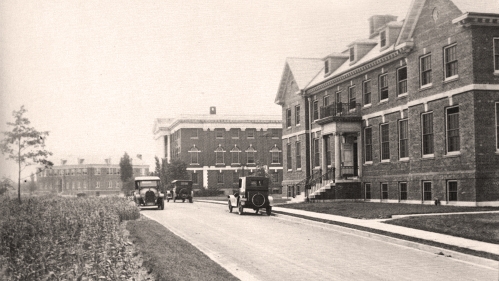
Our History
Established in 1766—ten years before Congress approved the Declaration of Independence—Rutgers University (then known as Queen's College) is the eighth oldest institution of higher learning in the Colonies and one of only nine colonial colleges established before the American Revolution.
The basis for what is today the Rutgers School of Environmental and Biological Sciences was formed in 1864 from an effort led by professor George H. Cook to designate Rutgers as New Jersey's land-grant college, two years after Congress passed the 1862 Morrill Act creating public, land-grant institutions across the nation. The Rutgers Scientific School was the distinct unit established to carry out the land-grant mission.
In 1880 the New Jersey Agricultural Experiment Station (NJAES)—the 3rd oldest in the U.S.—was set up to conduct applied agricultural research for the public interest. The school's affiliation with NJAES reflected the nation and the state's mission to extend knowledge to the predominant agricultural sector of the time. This was further facilitated by the Smith-Lever Act in 1914 that established the national Cooperative Extension system at each land-grant institution to disseminate information for the public good and the agricultural emphasis was reflected in 1917 when Rutgers Scientific School was renamed the College of Agriculture.
Rutgers Selected as New Jersey's Land-Grant School
This video gives a history of Rutgers as a land grant institution, which today is known as the School of Environmental and Biological Sciences and the New Jersey Agricultural Experiment Station.
As New Jersey grew into a more urban and suburban state indicating changing demands, in 1965 the College of Agriculture was re-titled the College of Agriculture and Environmental Science (CAES), the first land-grant institution to add a focus on the environment to its name. In 1971 the CAES changed its name to Cook College in honor of George H. Cook. Cook College was renamed the School of Environmental and Biological Sciences (SEBS) in 2007, as part of a university-wide reorganization of undergraduate education at Rutgers that also saw the adoption of the term "school" to designate all degree-granting units of the university.
Throughout its long history, the school has been home to many firsts and historical innovations, with worldwide impact: In 1934 the world-renowned Rutgers tomato was released, serving as the leading commercial variety for decades; in 1938 Enos Perry established the first dairy cow artificial insemination program in the US; in 1943 Albert Schatz and Selman Waksman discovered the life-saving tuberculosis drug streptomycin; in 1965 William Roberts innovated the first air-inflated, double-layer polyethylene greenhouse, revolutionizing a worldwide industry; in 2016 the Rutgers Slocum Electric Underwater Glider completed the first crossing of the South Atlantic by an autonomous underwater vehicle.
Rutgers and Streptomycin: First Tuberculosis Treatment
Today SEBS supports vibrant academic departments, research and outreach centers, and institutes addressing the scientific foundation of the pressing needs of the 21st century in the environment, climate, marine and coastal, agriculture, nutrition, plant biology, landscape design, food systems, and more.